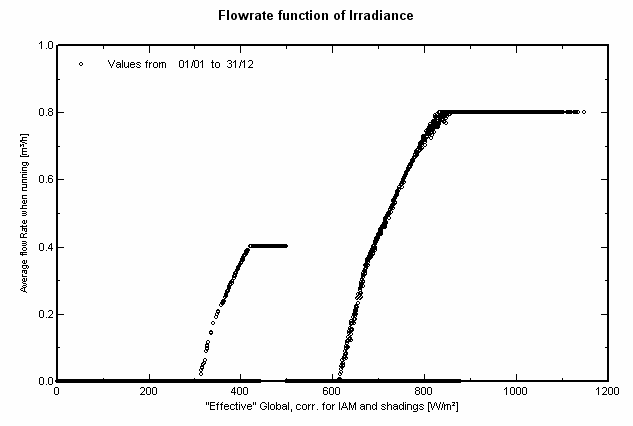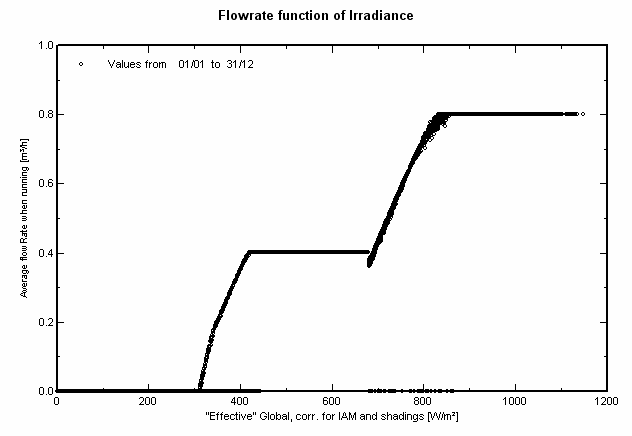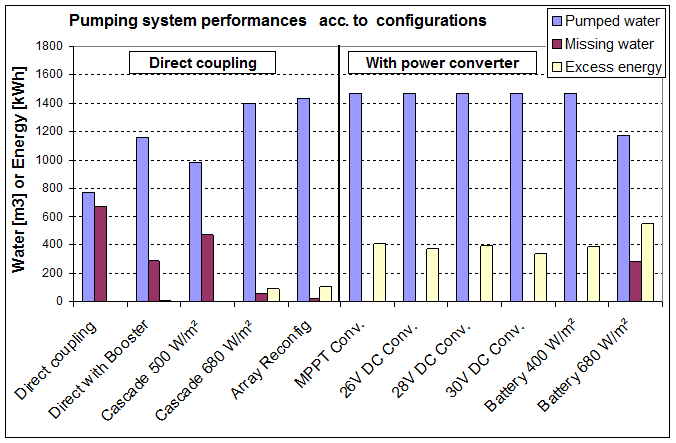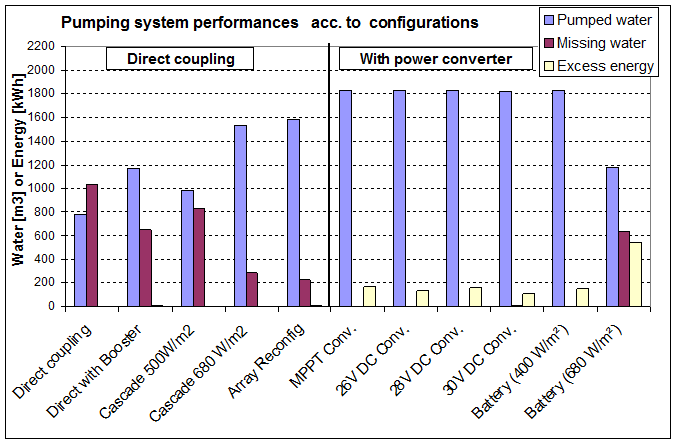Pumping Results: Examples
We would like to give here an example for comparing the performances of the different possible configurations of the system.
This corresponds to the project given as Demo for pumping systems.
We have imagined a Deep Well system at Dakar (Senegal, 15° latitude), with a static level depth of 32m, and a tank feeding altitude of 6m. The water needs are set at 4 m3/day, all the year.
The system includes a set of 2 pumps of 100 W each, positive displacement with DC motor, supplied by 4 PV modules of 60Wp, i.e. 240Wp (not ideal system of course: one only bigger pump would be better in this case, but this configuration allows to apply all the system configurations).
We simulated this system with all configuration options available in PVsyst. This gives the following results:
We can observe that all direct coupling configurations show lower performances than systems with power converters.
The direct coupling yields half the needs only. Although it is very dependent on the PV array sizing, the performances of such a configuration are always deceiving and strongly depend on details of the system sizing.
Introducing a booster device improves the situation; this overcomes the starting over-current set at 1A for this pump (in the lack of manufacturer's information, we have fixed this value arbitrarily; this corresponds to half the normal threshold current for this head).
Cascading of the two pumps can be an efficient improvement (but in practice needs 2 wells - or a very wide one for passing output pipes near the higher pump). But be careful: the starting threshold of the second pump is a crucial setting! If too low, the starting current will stop the running of the first pump, while in a very efficient irradiance range.
 |  |
The Predefined Graphs "Flowrate function of Irradiance" in the results is a suitable tool for understanding the behaviour and optimising the threshold ! Here for the 500 W/m² and 680 W/m² thresholds.
The array reconfiguration option shows quite similar performances as pump cascading. Although suitable controllers seem to be not available on the market, it is very easy to construct without deep investment in sophisticated electronics. And it may be used of course with one only pump, which avoids the practical disagreements of the pump's cascading.
As for cascading, the threshold determination is very important and should be carefully determined with the same tools.
Power converters offer of course the best results. And as expected, MPPT converter is the more efficient.
But we can observe that DC-DC converters with fixed input voltage are almost as efficient, and that the fixed voltage value is not critical. This could lead to cheaper converters, without MPPT algorithm implementation. It also allows to use standard converters, with standard (not solar) pumps.
Finally, the Battery Buffered system gives equivalent results as power converters. At the condition that the Pump starting threshold (with respect to irradiance) is set sufficiently low. Otherwise the pump is not running sufficiently often, and the battery becomes often over-charged. But of course it involves the use of a (little) battery pack, which has to be replaced periodically.
Water needs increase
We tried to increase the water needs to 5 m3/day, the limit for not missing water with the MPPT.
The results are given below: They are quite similar, and confirm that the converter technological options are rather equivalent. But the results of Cascading and Array Reconfiguration are a little worse with respect to converters.


